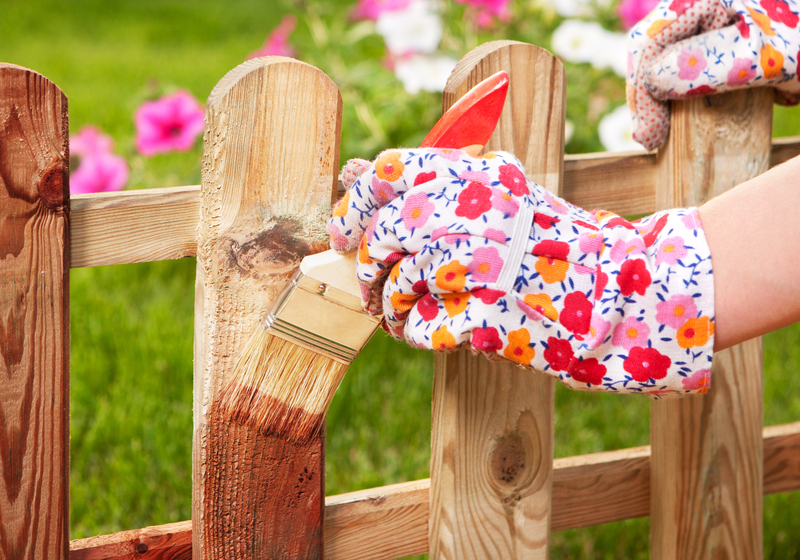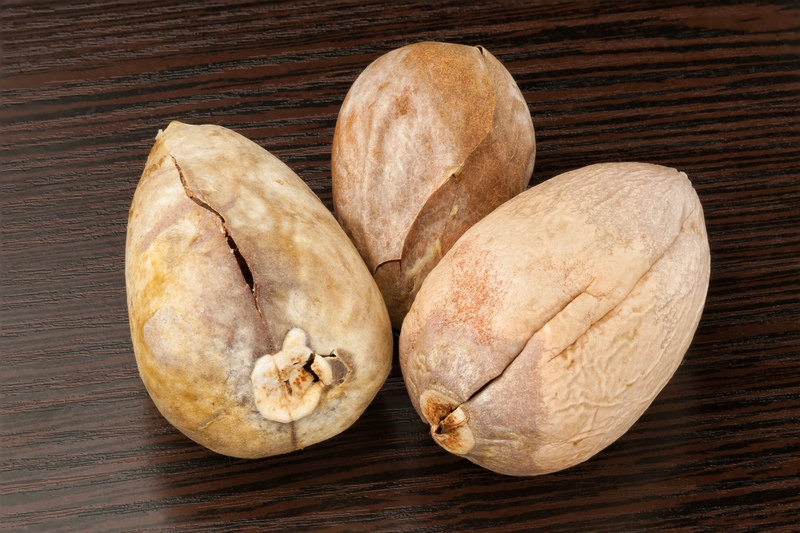Unlock the Potential of Shade with Evergreen Climbers
Posted on 25/09/2025
Unlock the Potential of Shade with Evergreen Climbers
Are you looking to liven up shaded parts of your garden? Discover how to unlock the potential of shade with evergreen climbers! These versatile and enduring plants are the secret weapon for gardeners, transforming dull, dark corners into vibrant, lush spaces all year round. In this comprehensive article, we'll delve into the benefits, selection, care, and design ideas for growing evergreen climbing plants in shadier spots.

Why Choose Evergreen Climbers for Shady Gardens?
Evergreen climbers are often underestimated, yet their value in landscape design is immense, especially for shaded areas. Below are some compelling reasons why these plants should top your list:
- Year-Round Foliage: Keep your garden green and vibrant throughout all seasons, even when deciduous plants have shed their leaves.
- Increase Biodiversity: Evergreen climbing plants provide habitats and food for birds and beneficial insects, even during winter.
- Natural Privacy and Screening: These climbers offer a natural screen for privacy or to hide unsightly walls, fences, or sheds.
- Soil and Temperature Protection: Their dense foliage protects soil from erosion, conserves moisture, and moderates garden microclimates.
- Low Maintenance: Most shade-loving evergreen climbers require minimal pruning and resist many common pests.
Top Evergreen Climbers for Shade: Varieties and Features
The key to thriving shady gardens is selecting plants that naturally flourish in low light. Here are some best evergreen climbers for shade you can confidently plant:
1. Hedera helix (English Ivy)
- Shade Tolerance: Excellent; thrives in deep and partial shade
- Features: Glossy dark-green leaves; tolerates most soils and conditions
- Benefits: Superb for covering walls, fences, and tree trunks year-round
- Care Tips: Trim regularly to keep in check and prevent invasiveness
2. Trachelospermum jasminoides (Star Jasmine)
- Shade Tolerance: Prefers partial shade to dappled sunlight
- Features: Deep green, glossy leaves with strongly scented white flowers in summer
- Benefits: Attractive in containers, pergolas, or walls; foliage turns bronze in winter
- Care Tips: Maintain moist but well-drained soil and prune after flowering
3. Lonicera henryi (Henry's Honeysuckle)
- Shade Tolerance: Thrives in partial to full shade
- Features: Narrow, glossy leaves with fragrant yellowish-red flowers in early summer
- Benefits: Evergreen in mild winters and attracts pollinators
- Care Tips: Requires moderate support; prune yearly to maintain shape
4. Fatshedera lizei (Tree Ivy)
- Shade Tolerance: Performs well in full or partial shade
- Features: Large, leathery leaves; a cross between Fatsia and Hedera
- Benefits: Slow-growing, ideal for trellises and shady corners
- Care Tips: Water consistently and protect young plants from frost
5. Clematis armandii
- Shade Tolerance: Best in dappled or partial shade
- Features: Long, leathery leaves and abundant scented white flowers in spring
- Benefits: Early blooms and quick coverage; excellent for fences and archways
- Care Tips: Regularly feed and mulch; prune after flowering
6. Euonymus fortunei 'Silver Queen'
- Shade Tolerance: Tolerates dense shade
- Features: Variegated silver-white and green foliage; climbs or rambles as needed
- Benefits: Brightens dark spaces and adds year-round interest
- Care Tips: Minimal pruning required; monitor for pests
Design Ideas: Transforming Shade with Evergreen Climbers
Unleash your creativity and maximize shady spots with evergreen climbers! Here are some captivating ways to integrate these resilient plants:
- Cover Unsightly Walls and Fences: Ivy, Euonymus, or Trachelospermum conceal unattractive boundaries and create a lush living backdrop.
- Add Height and Structure: Use trellises, pergolas, arbors, or obelisks that your climbers can ascend; this adds vertical interest and connectivity in your garden.
- Underplanting Trees: Train climbers around mature trees to add texture and color at lower levels.
- Create Secluded Retreats: Form living screens for privacy or shaded seating areas using dense foliage climbers.
- Mix and Match: Pair different leaf shapes, colors, and flower times for a dynamic all-year display.
- Container Gardens: Many shade-tolerant evergreen climbers do well in large containers, ideal for patios or balconies with limited sunlight.
How to Plant and Care for Evergreen Climbers in the Shade
1. Preparing the Soil
Most shade-tolerant climbers prefer soil that is well-drained yet moisture-retentive. Improve poor soils by digging in organic matter such as compost or leaf mold, which will provide nutrients and help hold moisture.
2. Planting Position
Pick a spot where the climber's roots will be in cool, moist soil, but where the upper growth can still get filtered light. Avoid deep, dry shade unless the chosen species is specifically tolerant of such conditions (e.g., English Ivy).
3. Supports and Training
Provide trellises, wires, or netting for your plant to climb. Install supports before planting to avoid damaging roots later. As the plant grows, gently tie new stems to supports with soft garden ties.
4. Watering and Feeding
- Adequate, even moisture is crucial, especially during the first year.
- Mulch around the base to retain soil moisture and reduce temperature fluctuations.
- In spring, feed with a balanced, slow-release fertilizer to encourage healthy growth and foliage.
5. Pruning and Maintenance
- After flowering (or in early spring for non-flowering types), trim back overlong or wayward shoots to maintain shape and provoke bushier growth.
- Remove any dead or damaged stems promptly.
- Check and re-tie as climbers grow to keep them securely attached to their supports.
Overcoming Common Challenges When Growing Evergreen Climbers in Shade
While evergreen climbers are resilient, shade gardening has some unique challenges. Here are key solutions:
- Sparse Foliage: If growth is thin, feed with high-potash fertilizer and increase organic matter around the roots.
- Poor Flowering: Some shade is fine for most climbers, but too little light may limit blooms. Place near light-dappled locations for best results.
- Fungal Issues: Cool, damp spots are prone to mold. Ensure good air circulation and remove affected foliage promptly.
- Pest Attacks: Watch for aphids or scale insects which sometimes shelter under dense leaves. Use environmentally friendly pest controls as needed.
Sustainable Benefits: Evergreen Climbers for the Environment
Beyond visual impact, evergreen climbers for shade serve a greater role in a healthy ecosystem:
- Carbon Storage: Their dense, year-round foliage absorbs and sequesters carbon dioxide, helping counteract climate change.
- Air Filtration: Leaves trap dust and pollutants, improving your garden's air quality.
- Wildlife Habitat: Birds and insects find shelter and overwintering spots in thick climbing vines.
- Soil Conservation: Deep roots prevent erosion, especially on slopes and shaded woodland edges.
Creative Combinations: Companion Plants for Shady Evergreen Climbers
For a rich tapestry of color and form in shaded areas, combine shade-loving evergreen climbers with other compatible plants, such as:
- Hostas: Broad leaves contrast beautifully with fine ivy or honeysuckle foliage.
- Ferns: Provide texture beneath climbers, reflecting the layered beauty of wild woodlands.
- Snowdrops and Bluebells: Add spring color at the base of vertical climbers.
- Brunnera or Pulmonaria: Silver or variegated leaves brighten up dark spots under climber-draped fences or walls.

Frequently Asked Questions about Evergreen Climbers in the Shade
Q: Will evergreen climbers damage my walls or structures?
Most shade-loving climbers are safe for structures. English Ivy can sometimes compromise older brickwork if not managed. Choose self-clinging types carefully or use support systems that keep vines away from walls.
Q: Can I grow evergreen climbing plants in containers in shade?
Absolutely! Many climbers adapt well to large containers. Provide sturdy supports and high-quality, moisture-retaining compost.
Q: How long until my climbers cover a fence or trellis?
Growth rate depends on the species. Ivy and honeysuckle are fast; star jasmine and clematis take longer but reward patience with beauty and fragrance.
Q: Do I need to feed evergreen climbers regularly?
Yes, annual feeding with a balanced fertilizer in spring keeps them healthy and lush, especially in poor soils or containers.
Conclusion: Bring Life to the Shadows with Evergreen Climbing Plants
Don't let shaded corners of your garden sit forgotten or underused! Unlock the potential of your shade with evergreen climbers and enjoy the benefits of year-round texture, greenness, and vitality. Whether you want to conceal unsightly walls, create a leafy haven for wildlife, or inject life and color even on winter's darkest days, these remarkable plants offer a sustainable, resilient, and beautiful solution.
By selecting the right species, providing suitable support, and following straightforward maintenance steps, you can transform even the shadiest spot into a garden highlight. Explore the range of shade-tolerant evergreen climbers and let your creativity and garden flourish--no matter how little sunlight you have.
Embrace the possibilities, and watch neglected shade turn into your garden's greatest asset!

